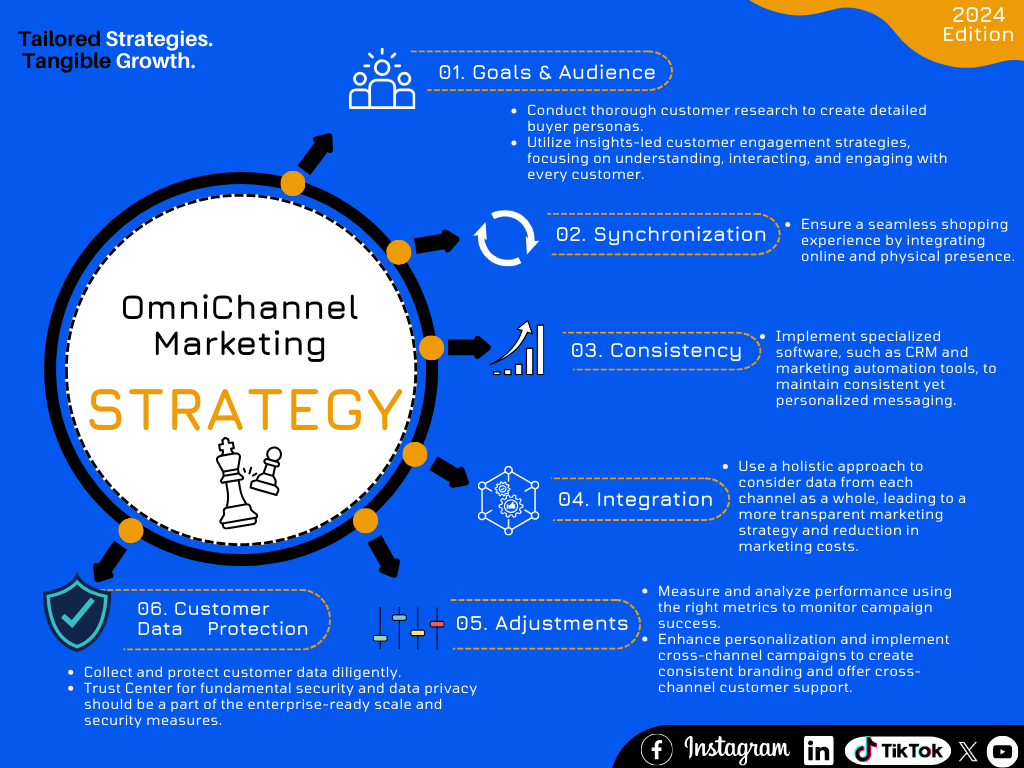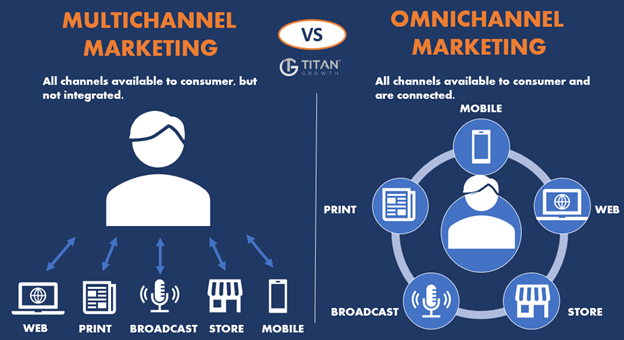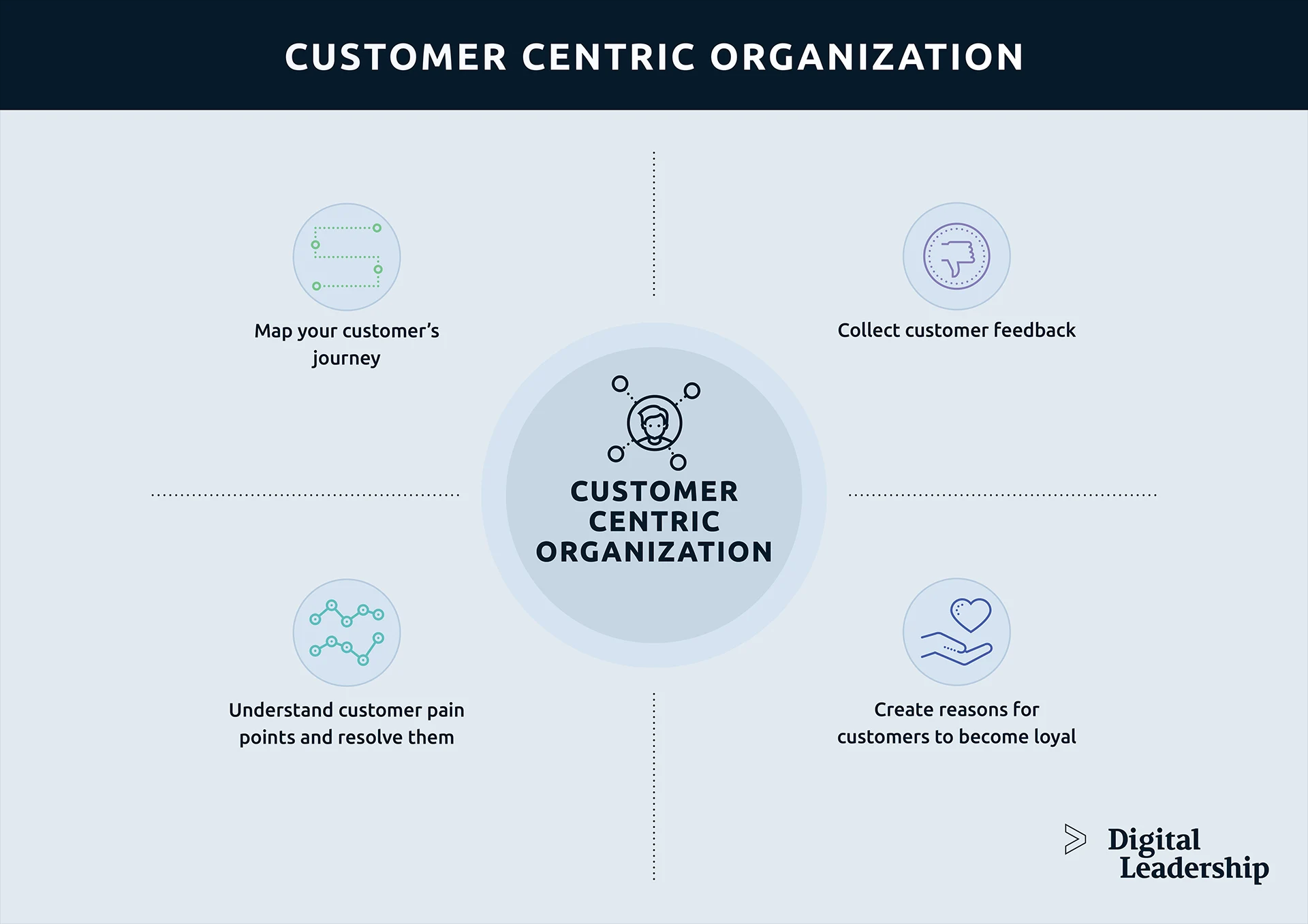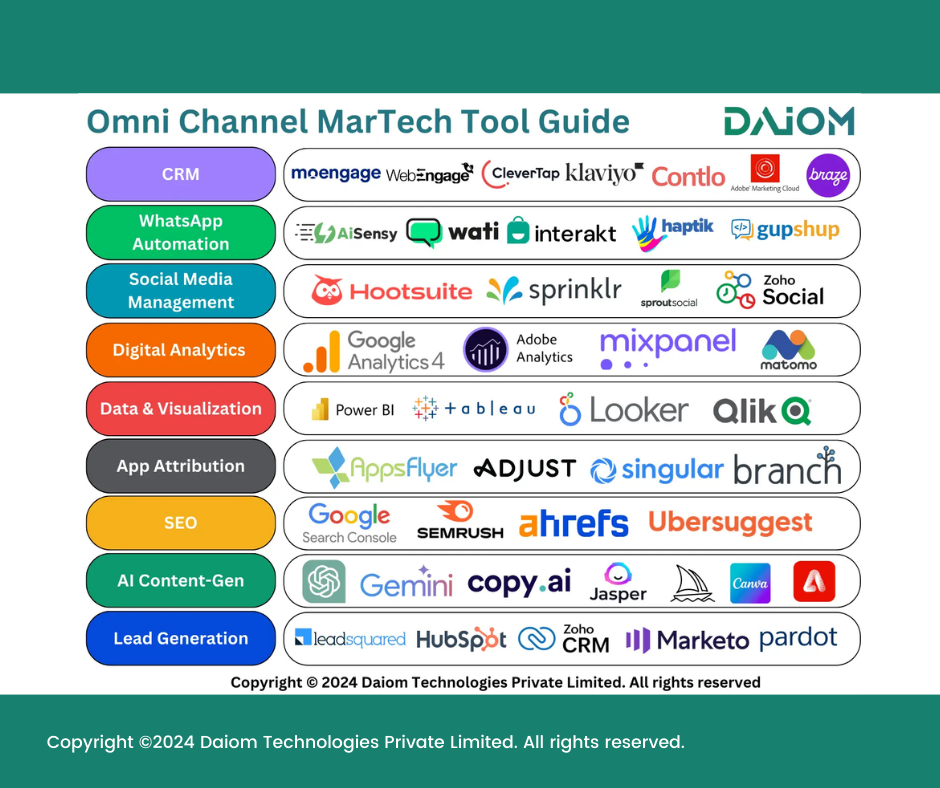A customer walks into your store, having received a personalised offer on their mobile phone just moments before. They find exactly what they need, informed by their previous online searches, and complete their purchase without a hitch. Now, imagine this seamless experience replicated across every touchpoint—whether online, in-store, or via a mobile app.
This isn’t just the future of marketing; it’s the present-day reality for brands that have embraced omni-channel marketing. However, achieving this level of cohesion is no small feat. Many businesses struggle to unify their customer touchpoints, leading to fragmented experiences that can erode trust and loyalty. From mapping out your customer journey to integrating cutting-edge technology and personalising interactions at every stage, we’ll walk you through a step-by-step approach to developing a robust omni-channel marketing strategy.
- Map the Customer Journey: Start by identifying every touchpoint your customers interact with, both online and offline, to ensure a cohesive and seamless experience across all channels.
- Leverage Technology for Integration: Use CRM systems and data analytics to track customer behaviour across channels, ensuring that all interactions are unified and personalised.
- Ensure Consistent Messaging: Develop a brand playbook that maintains consistent messaging, offers, and customer service across all touchpoints, enhancing brand loyalty.
- Implement Real-Time Personalisation: Utilise first-party data to personalise customer interactions as they happen, offering tailored content and promotions that resonate with individual preferences.
- Overcome Data Silos: Invest in data integration platforms that consolidate customer information from various sources, eliminating silos that can disrupt the omni-channel experience.
- Optimise Resource Allocation: Prioritise channels based on customer engagement and ROI, ensuring that resources are allocated effectively to maximise impact.
An omni channel marketing strategy focuses squarely on meeting the needs and preferences of the consumer, rather than favouring specific platforms or devices. To achieve this, businesses must develop a deep understanding of the entire customer journey, including the variety of channels that customers use to interact with the brand and the context in which these interactions occur.
The term “omni” translates to “all,” while “channel” refers to the numerous touchpoints through which customers engage with a business. These can range from physical stores to online browsing, social media interactions, emails, apps, SMS, and other digital environments. By employing an omni channel digital marketing strategy, businesses can meet consumers where they are, delivering personalised service aligned with their preferences and needs. For the purpose of this article, we’ll use the terms “customers,” “consumers,” and “shoppers” interchangeably, as the principles of an omni channel marketing strategy apply to both B2B and B2C contexts.
What Matters Most?
Building an audience-first approach is crucial for omni-channel success. Clients often find that focusing on content that resonates and builds long-term relationships creates a powerful foundation for engagement across all touchpoints. Additionally, we typically advise prioritising quality over quantity; ensuring that every interaction adds meaningful value is key to maintaining customer attention and trust. Real-time analytics also play a critical role in omni-channel strategy.Get In Touch
What are three key characteristics of Omni channel marketing?
Here are three core characteristics that define a successful omni channel marketing strategy:
- High Degree of Integration
One of the fundamental aspects of an omni channel marketing strategy is the seamless integration of all channels, ensuring a unified customer experience. Customers should be able to move effortlessly between different platforms without encountering inconsistencies. For instance, a customer may start researching a product on their mobile device, only to complete their purchase in a physical store. The essence of omni channel optimisation is that the customer journey is uninterrupted, with each touchpoint complementing the others.
To achieve this, organisations must develop a deep understanding of their customers’ preferences, behaviours, and needs. By analysing data from multiple channels, businesses can craft personalised experiences that resonate with individual customers. This data-driven approach allows for the refinement of marketing efforts, ensuring that every interaction is relevant and adds value. - Consistency in Messaging and Branding
A consistent brand message across all channels is vital to the success of any omni channel digital strategy. Whether customers engage with a brand through social media, a website, in-store, or via mobile apps, they expect a coherent experience that reflects the brand’s identity. Omni channel digital marketing strategies rely heavily on technology to ensure that the same voice, tone, and visual identity are maintained across all platforms, reinforcing trust and brand recognition.
Inconsistencies in branding, whether in tone or service quality, can lead to customer confusion and frustration. These disruptions not only harm the customer experience but also damage brand loyalty. A consistent omni channel marketing strategy is essential for building trust and loyalty, ensuring that each customer interaction reinforces the brand’s values and messaging. - Customer-Centric Approach
At the heart of an effective omni channel marketing strategy is the customer. The focus is firmly on understanding customer preferences and behaviours to create tailored experiences that foster trust and loyalty. By adopting a customer-centric approach, businesses can offer personalised, seamless interactions that meet the exact needs of their audience. This not only increases customer satisfaction but also helps companies gain a competitive advantage.
In a market where customers have more choices than ever, being able to anticipate and meet their needs is a crucial differentiator. A customer-centric omni channel digital marketing strategy can lead to stronger relationships, higher customer retention, and increased profitability. Satisfied customers are more likely to return for repeat purchases and recommend the brand to others, which drives both short-term gains and long-term growth.

Multichannel vs Omnichannel Marketing
At first glance, omni channel marketing strategies may seem similar to multichannel marketing, and it’s not uncommon for these terms to be used interchangeably. However, it’s essential to understand the clear distinction between the two approaches.
Multichannel marketing refers to any campaign that utilises more than one platform, and this definition has been in use for quite some time. It’s not confined to the digital realm—campaigns that include TV commercials and print adverts, for example, fall under the umbrella of multichannel marketing. The focus is on distributing content across various platforms, often with separate strategies tailored for each.
In contrast, omni channel marketing strategies take a more integrated approach. Rather than treating each channel as a separate entity, an omni channel digital marketing strategy creates a cohesive customer experience across all platforms. The goal is to ensure that no matter where the customer interacts with the brand—whether online, in-store, or via mobile—they receive a seamless, unified experience.

What is the relation between CRM and omni channel marketing?
The essence of omni channel marketing lies in creating a streamlined, cohesive shopping experience for customers. Today’s audiences expect more personalised and relevant messaging, and by integrating a CRM with omni channel optimisation, brands can deliver highly tailored and engaging content that improves performance across all key metrics in digital marketing.
A focus on providing real value through positive customer interactions is essential for long-term retention. Rather than relying solely on immediate sales tactics, an omni channel digital strategy focuses on building trust and improving the overall lifetime value of each customer. This approach fosters deeper relationships and ultimately results in more sustainable growth.
While a CRM system manages the bulk of customer data and engagement, incorporating omni channel digital marketing strategies can enhance these efforts by offering a more integrated and personalised experience across all channels.
Source: OmniSend
What Channels Should I Include in an Omni Channel Marketing Strategy?
A robust omni channel marketing strategy leverages a range of essential channels to ensure seamless and engaging interactions across all customer touchpoints. Let’s explore the key channels that form the foundation of a comprehensive omni channel digital marketing strategy.
Email Marketing
With one of the highest ROIs among digital channels, email marketing remains central to many omni channel marketing strategies. By integrating email into your broader strategy, you can achieve several critical objectives:
- Deliver personalised communication at scale: Utilising an omni channel digital strategy, you can create automated email campaigns enriched with personalisation tokens that adapt content based on previous purchases, product preferences, browsing history, and more.
- Precise audience segmentation: Easily and accurately target specific groups of customers, whether through demographic data or their engagement across web, mobile, and other key channels.
- Encourage repeat purchases: Harness the power of AI insights to send timely and relevant emails to individual subscribers, driving conversions at just the right moment.
Mobile Marketing
With mobile usage continuing to rise—accounting for 61% of global web sessions—mobile marketing has become an indispensable part of any omni channel digital marketing strategy. By leveraging mobile channels, brands can engage customers in real time through several methods:
- Mobile Push: Send highly targeted messages directly to users’ lock screens, allowing you to engage them with content tailored to their behaviour and preferences.
- In-App Messaging: Backed by an omni channel optimisation platform, in-app messaging enables you to deliver personalised product recommendations and offers at key stages of the customer lifecycle.
- Mobile Inbox: Ensure customers never miss out on your key promotions by maintaining a dedicated inbox within your app.
- Mobile Wallet: Engage customers without the need for a dedicated app by delivering coupons, tickets, and vouchers directly to Apple or Google Wallet, which can be redeemed in-store.
SMS Marketing
The average person checks their phone 144 times a day, presenting a prime opportunity for brands to engage their audience with targeted SMS marketing. By incorporating SMS into your omni channel marketing strategy, you can:
- Boost email opt-ins: Use SMS to gather valuable first-party data while reinforcing other communication channels, such as email.
- Streamline the buyer journey: Automate SMS messages triggered by specific customer actions, reducing friction and increasing conversion rates.
- Decrease cart abandonment: Send timely SMS reminders to customers who have left items in their cart, prompting them to complete their purchase.
- Re-engage at-risk customers: Reach out to disengaged or churn-risk customers with direct, personalised SMS messages that land straight on their lock screens.
Digital Advertising
Digital advertising plays a critical role not only in customer acquisition but also in encouraging repeat conversions. By integrating CRM data with your omni channel digital marketing strategy, digital ads can drive more meaningful engagement across display, search, and social channels. Here’s how:
- Deliver personalised ad content: Use CRM insights to create dynamic ads that deliver the right message to the right customer at the right time.
- Build smart segments and lookalike audiences: Identify key customer segments and use lookalike audiences to expand your reach.
- Optimise your media spend: Focus your budget on the channels and campaigns that deliver the highest returns.
- Take campaigns cross-channel: Extend your digital ad strategy across email, web, in-app, SMS, and more for a fully integrated approach.
Direct Mail
Direct mail remains an often underutilised yet highly effective channel within a well-rounded omni channel marketing strategy. With significantly higher open rates than email, direct mail offers a personal touch in an increasingly digital world. By integrating direct mail with an omni channel digital strategy, you can:
- Combine online and offline data: Deliver personalised experiences that bridge digital and physical touchpoints, creating a unified customer journey.
- Connect direct mail with other channels: Use insights from digital behaviour to trigger relevant mailings, enhancing the overall customer experience.
- Automate delivery based on cross-channel interactions: Build sophisticated automations that send targeted direct mail based on pre-defined customer behaviours across various platforms.
Our Tactical Recommendations
Optimising content distribution with SEO and search intent helps clients ensure their omni-channel strategy reaches the right audience. Predicting customer behaviour using AI insights often proves effective in engaging the right customers at the right time across channels. We also guide clients to focus on creating frictionless transitions between channels; clients often discover that reducing friction and making the customer journey seamless across platforms dramatically improves the overall experience.Get In Touch
How to Optimise Your Omni Channel Marketing Strategy
To maximise the impact of your omni channel marketing strategy, it’s essential to enhance your online presence, streamline customer support, and integrate all channels for a seamless customer experience. Here’s how you can optimise each aspect of your strategy:
Enhance Your Online Presence
Your online presence is crucial, even if your brand primarily operates from physical stores. It’s imperative that your digital efforts align perfectly with your in-store branding and messaging.
Ensure that your brand image is cohesive and that the user experience across all channels is smooth and friction-free. When consumers have positive experiences with your brand across multiple platforms, your reputation strengthens, keeping your business top of mind. Here are key areas to assess when auditing your online presence:
- Consistent imagery and messaging across all social media platforms.
- Mobile-friendly website with simple UX design and clear calls to action (CTAs).
- Frictionless experience within your app to maintain engagement.
A well-optimised omni channel digital strategy ensures that no matter where or how customers engage with your brand, their experience is seamless.
Source: Hubtype
Prioritise Customer Support
The customer journey doesn’t end with the purchase. Customer support is a critical component of the overall experience, and providing exceptional support can turn one-time shoppers into loyal customers. Conversely, a poor customer support experience can drive them away for good.
Offer support through multiple channels and tailor it to create a warm, personalised experience. Friendly and responsive support specialists play a crucial role in building long-term customer loyalty.

Collect and Protect Customer Data
As you refine your omni channel digital marketing strategy, continuously adjust your targeting, messaging, and other elements based on customer data. It’s vital to make data-driven decisions, rather than relying on trends or assumptions. Analyse the results you gather across all channels to guide your strategy updates and ensure that they are grounded in solid evidence.
Seamlessly Integrate All Your Channels
Simply setting up multiple channels isn’t enough—you must seamlessly integrate them to allow customers to move fluidly between devices and platforms. An omni channel optimisation strategy ensures that customers can switch between channels effortlessly, connecting with your brand in a consistent way.
Avoid treating each channel as a separate entity. Instead, focus on creating a coordinated system where each channel complements and reinforces the others. For example, a customer browsing your website on their desktop should be able to continue their journey via a social media platform or mobile device, without interruption.

Leverage Google Dashboards
Google Dashboards can be a powerful tool for visualising data from multiple sources in a single, centralised view. By summarising reports across various channels, this tool makes it easier to interpret data and inform strategic decisions.
Use Google Dashboards to visualise all your essential data and metrics, including audience segmentation insights. This will enhance your ability to make informed decisions that boost your omni channel marketing strategies and improve overall performance.
Make Data-Driven Channel Choices
An effective omni channel digital strategy prioritises channels and devices that resonate most with your target audience. To enhance customer engagement and satisfaction, brands must maintain a strong presence across all relevant channels and utilise first-party data, such as marketing analytics and user feedback, to tailor their strategy.
Coordinate Omni Channel Efforts Across the Business
To deliver a streamlined and unified customer experience, it’s crucial to coordinate your omni channel marketing strategy across all departments, from marketing to customer support and sales. Ensure that every team involved is equipped to manage the process effectively, delivering a consistent experience at every customer touchpoint.
Develop staffing plans that align with your marketing strategy to ensure customers receive the help they need, whether they are making a purchase or require further information. This preparation should extend to both on-site and remote teams, with careful alignment across all departments to ensure they follow the same strategies, processes, and brand guidelines.







